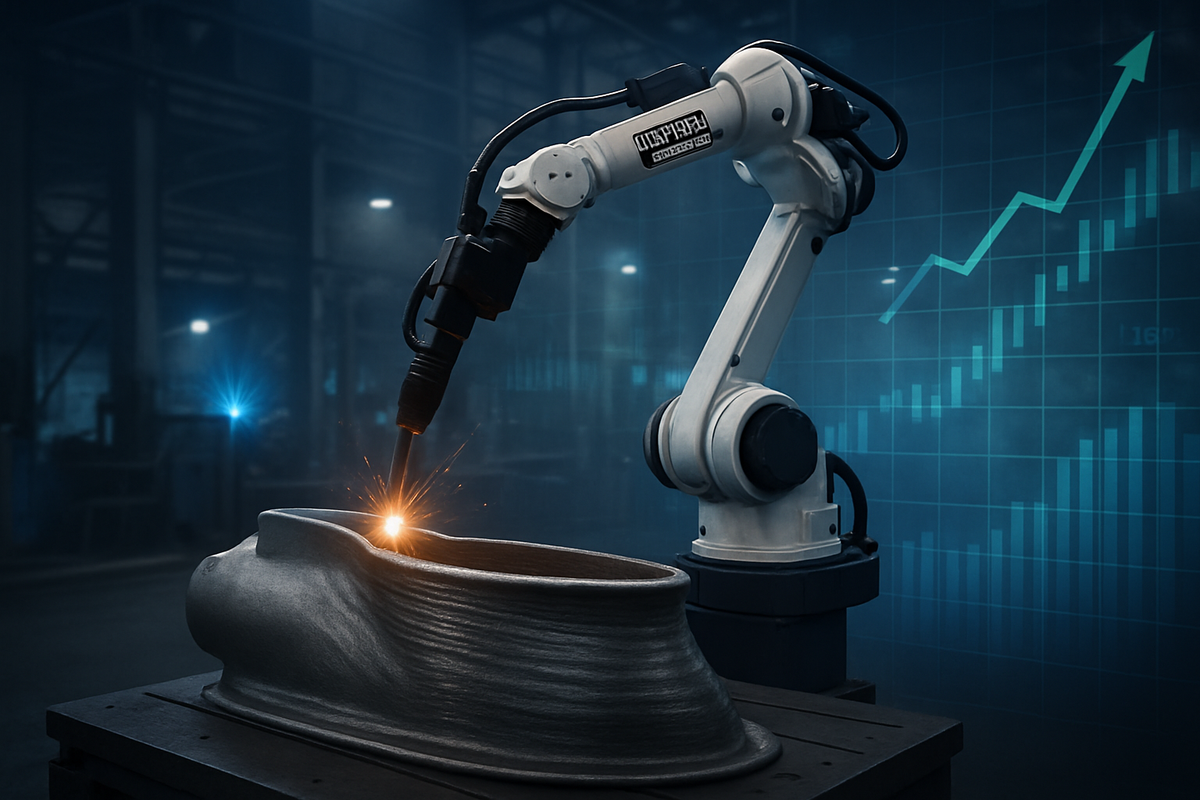
Cleveland, OH – October 5, 2025 – Lincoln Electric Holdings Inc. (NASDAQ: LECO), a global leader in arc welding and cutting solutions, finds its stock performance increasingly influenced by a blend of robust financial health, strategic technological advancements, and the ever-present dynamics of retail investor sentiment. While the company has historically demonstrated resilience through economic cycles, a recent landmark partnership with the U.S. Navy and General Dynamics, announced on October 3, 2025, has underscored its pivotal role in industrial innovation, particularly in the burgeoning field of additive manufacturing. This development, coupled with ongoing analyst optimism, provides a fresh lens through which to examine the forces steering LECO's valuation and the critical risk factors investors must weigh.
The immediate implications of this strategic alliance are significant, positioning Lincoln Electric at the forefront of defense manufacturing and potentially opening new avenues for growth beyond its traditional markets. For retail investors, who often seek companies with strong fundamentals and clear growth narratives, LECO presents a compelling, albeit complex, investment case. Understanding the interplay between the company's operational strengths, its strategic pivots, the broader economic landscape, and inherent market risks is paramount for making informed decisions in today's dynamic financial environment.
Strategic Innovation Propels Lincoln Electric Amidst Market Shifts
Lincoln Electric's recent announcement on October 3, 2025, detailing a major partnership with the U.S. Navy and General Dynamics to enhance submarine production using advanced 3D printing (additive manufacturing) stands as a testament to the company's commitment to innovation. This collaboration aims to significantly reduce lead times for critical components, a strategic leap in operational capabilities that could redefine manufacturing processes within the defense sector and beyond. The news immediately resonated with the market, as LECO's stock price gained 2.04% on the day of the announcement, accompanied by an increase in trading volume—a positive technical indicator reflecting investor confidence.
This pivotal event follows a period of consistent financial strength for Lincoln Electric. For fiscal year 2024, the company reported approximately $4 billion in sales and an impressive earnings per share (EPS) of $2.57, marking a 5% year-over-year growth. This positive trajectory continued into the second quarter of 2025, with net sales reaching $1.09 billion, an operating income margin of 17.6%, and diluted EPS of $2.56, surpassing analyst expectations. The company's remarkable track record of increasing its dividend for 30 consecutive years, maintaining a sustainable payout ratio of 30%, further bolsters investor trust and highlights its financial discipline.
Key players in this evolving narrative include not only Lincoln Electric's management, driving these strategic initiatives, but also the institutional investors such as Vanguard Group Inc., BlackRock Inc., and State Street Corp., who actively adjust their substantial positions, often adding shares to their portfolios. While specific granular data on retail trading trends for LECO is not directly available, the stock's "very controlled movements" and "good liquidity" suggest a relatively stable environment, which can be attractive to individual investors. However, a notable observation is the "significant insider selling" over the past three months, with executives selling shares in August and September 2025, a factor that always warrants careful consideration from retail investors.
The Ripple Effect: Winners, Losers, and Market Dynamics
The strategic move into additive manufacturing, particularly with a high-profile partner like the U.S. Navy, positions Lincoln Electric (NASDAQ: LECO) as a potential long-term winner. This partnership not only diversifies its revenue streams but also demonstrates the company's ability to adapt its core competencies to cutting-edge technologies. By reducing lead times for critical components, LECO could unlock substantial value in the defense sector, setting a precedent for other heavy industries to adopt similar advanced manufacturing techniques. This could lead to increased demand for Lincoln Electric's specialized equipment and expertise in welding and 3D printing, creating a competitive advantage.
Conversely, traditional welding equipment manufacturers who lag in adopting advanced technologies like additive manufacturing might find themselves at a disadvantage. While the arc welding and cutting industry is mature and cyclical, those companies heavily reliant on conventional methods and less diversified into high-growth sectors could experience market share erosion. The anticipated recovery in 2025, driven by eased monetary policy and stronger capital spending across industrial sectors, could benefit all players, but those with innovative edges, like LECO, are better positioned to capitalize on this upswing.
However, LECO is not immune to broader economic headwinds. "Bears" in the market point to a projected slowdown in North American industrial production and sluggish demand in the electric vehicle (EV) sector as potential headwinds for earnings in 2025. These factors could impact the company's general fabrication and automotive end markets. Furthermore, the intense competition within the welding industry, coupled with sensitivity to raw material price fluctuations, means that even with strategic wins, profitability can be challenged. The company's "high level of debt" also represents a financial risk, especially if interest rates were to climb unexpectedly or if economic conditions deteriorate, making debt servicing more burdensome.
Broader Significance: Industrial Evolution and Strategic Imperatives
Lincoln Electric's foray into large-scale additive manufacturing for defense applications marks a significant moment in broader industrial trends. It signifies a paradigm shift where traditional manufacturing powerhouses are embracing cutting-edge technologies to enhance efficiency, reduce costs, and strengthen national security supply chains. This event fits squarely into a wider movement towards Industry 4.0, emphasizing automation, data exchange, and advanced manufacturing techniques across sectors. The successful implementation of 3D printing for submarine components could accelerate the adoption of similar technologies in other heavy industries like aerospace, energy, and infrastructure, creating a ripple effect across the manufacturing ecosystem.
The partnership also highlights the increasing integration between the private sector and government initiatives, particularly in critical areas like defense. This trend could lead to more robust regulatory frameworks supporting innovation in manufacturing, potentially involving incentives for companies investing in advanced technologies and skilled labor development. Historically, periods of significant technological advancement, often spurred by defense needs, have catalyzed broader industrial growth and reshaped competitive landscapes. For instance, the development of advanced materials and manufacturing techniques during World War II had lasting impacts on civilian industries.
Potential ripple effects extend to suppliers of materials for additive manufacturing, software developers for design and simulation, and training institutions focused on developing a skilled workforce for these new processes. Competitors in both traditional welding and emerging additive manufacturing spaces will be closely watching LECO's progress, potentially spurring their own R&D investments or strategic partnerships. This competitive pressure could lead to a faster evolution of manufacturing capabilities industry-wide, ultimately benefiting end-users through more efficient and resilient supply chains.
What Comes Next: Navigating Opportunities and Challenges
Looking ahead, Lincoln Electric's partnership with the U.S. Navy and General Dynamics presents both short-term and long-term possibilities. In the short term, successful execution of the initial phases of the additive manufacturing project will be crucial. This could lead to further contracts and expansion of the technology to other defense platforms or even commercial applications requiring high-precision, robust components. The immediate market opportunity lies in demonstrating the scalability and reliability of their 3D printing solutions, potentially boosting investor confidence and attracting new clients.
Long-term, LECO could strategically pivot further into advanced manufacturing services and solutions, diversifying its offerings beyond traditional equipment sales. This might involve increased investment in R&D for new materials, software, and automation for additive manufacturing, or even strategic acquisitions of companies with complementary expertise. The company's ability to integrate these new technologies seamlessly into its existing global operations will be key to sustaining growth and maintaining its competitive edge.
However, challenges remain. The cyclical nature of its core industrial markets means LECO will need to continue balancing its innovative pursuits with managing demand fluctuations in general fabrication, energy, and heavy industries. The "high level of debt" also requires careful management, especially if economic conditions tighten. Investors should watch for further announcements regarding the progress of the U.S. Navy partnership, the company's capital allocation strategies, and its performance in navigating potential slowdowns in sectors like North American industrial production and EV demand. Potential scenarios range from LECO becoming a dominant force in industrial additive manufacturing to facing integration hurdles or increased competition from new entrants in the advanced manufacturing space.
Comprehensive Wrap-up: A Leader in Transition
Lincoln Electric Holdings Inc. (NASDAQ: LECO) stands at a critical juncture, demonstrating both the resilience of a mature industrial leader and the agility of an innovator. The recent U.S. Navy and General Dynamics partnership for additive manufacturing highlights a significant strategic direction, positioning the company to capitalize on advanced technologies that could redefine industrial production. This move, coupled with a history of strong financial performance and consistent dividend growth, paints a picture of a company actively shaping its future.
Moving forward, the market will closely assess how effectively Lincoln Electric integrates and scales its additive manufacturing capabilities while continuing to navigate the inherent cyclicality and competitive pressures of its core welding and cutting markets. The company's ability to manage its debt, adapt to evolving regulatory landscapes, and mitigate risks associated with international operations and supply chain disruptions will be paramount. For investors, LECO offers a blend of stability and growth potential, driven by innovation.
Key takeaways include the importance of strategic technological investments in driving future growth, the enduring value of strong financial fundamentals, and the necessity for investors to consider both market opportunities and inherent risks. What investors should watch for in the coming months includes updates on the U.S. Navy project, economic indicators impacting industrial production, and Lincoln Electric's quarterly earnings reports for insights into its operational efficiency and strategic execution. The journey of Lincoln Electric serves as a compelling case study of an industrial giant transitioning and adapting in an ever-evolving global economy.
This content is intended for informational purposes only and is not financial advice.




